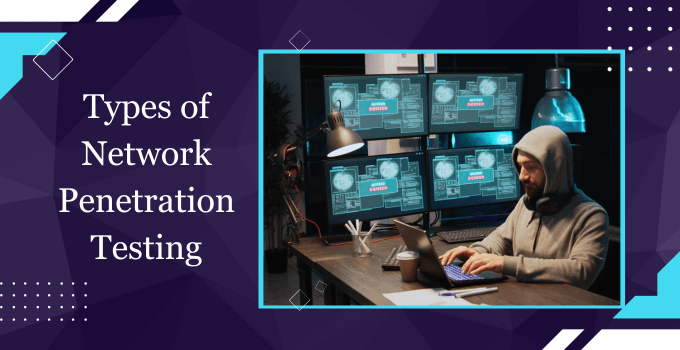Network Penetration Testing Guide: Secure Yourself From Cyber Threats

Getting troubled about cyber security in today’s world is obvious. When everything is interconnected and hackers are evolving daily, securing your online presence becomes crucial. Cyber attackers and potential hackers are always watching like hawks to find a loophole in your system. Have you ever wondered how experts ensure their environment is secure from cyber threats? The answer is Network Penetration Testing.
Network penetration testing helps you find the strength of your network and identifies the potential vulnerabilities before hackers. Such testing is required to see if your cyber security measures work as expected in the case of actual attacks.
In this guide, we have mentioned everything you need to know about network penetration testing. Whether you are a beginner or a networking expert, you will learn something new here.
What is Network Penetration Testing?
A Network Penetration Testing (Network Pen Test) is a simulated cyber attack on the organization’s servers and network system to check and identify its vulnerabilities. It can involve breaching attempts to application systems, frontend, and backend servers to pick out the vulnerabilities. The findings of these tests can be used to improve and refine security policies.
Network Pen Tests use the real-life tools and skills the actual hackers would use to crack a system and provide critical information about the network’s security.
Types of Network Penetration Testing

We can point out five types of network penetration testing according to their purpose. Let’s understand them individually to help you identify which strategy helps you secure your system perfectly.
External Network Penetration Testing
External Network Penetration Testing (External Pen Tests) is a security assessment practice focused on identifying and addressing vulnerabilities that are visible from the internet. It can be considered the outer wall of your network security. This test specifically targets web applications, network devices, and any other entry point that is accessible from the Internet. It helps you identify weaknesses that could be exploited by external threats. External penetration testing is important to mitigate the risk of data breach and unauthorized access, ensure a robust defense for internet-faced assets, and protect against potential cyber threats from the Internet.
Internal Network Penetration Testing
Unlike external penetration testing, the aim of Internal Network Penetration testing is inward. It assesses the security of your system within your organization’s internal network. It focuses on identifying the vulnerabilities that can arise from within the network, and potential risks from employee activities. Internal Penetration Testing specifically targets internal servers, databases, employee workstations, and other in-house network devices. It helps you evaluate the effectiveness of internal security measures. Internet Pen Testing is important to identify and uncover insider threats, ensure that even if the external defense is breached, the internal system remains secure, and enhance the internal security protocols.
Automated Network Penetration Testing
As the name suggests, Automated Network Penetration Testing uses specialized tools and software to streamline the assessment process. These tools and software scan and test automatically to quickly identify the vulnerabilities and potential security risks. The primary objective of this testing is the rapid identification of vulnerabilities using automated tools. It reduces the time and manual effort required for testing and can be suitable for regular and frequent assessments. However, it cannot possibly capture the advanced vulnerabilities that require a human touch. Automated Pen Testing is important for common and known vulnerabilities, contemplating manual testing as a comprehensive testing strategy, being time-efficient, it allows more frequent assessments.
Wireless Network Penetration Testing
The Wireless Network Penetration Testing is aimed at testing the security of Wi-Fi connections and networks. As the world is becoming increasingly connected wirelessly, protecting these networks is vital to prevent any unauthorized access. It also helps you protect sensitive information from being leaked from such sources. It specifically targets Wi-Fi Routers, access points, and connected devices. The method involves simulated attacks on wireless networks to uncover potential risks and identify and address their vulnerabilities. The process can include tools like Wireshark and Aircrack-ng. Wireless Pen Testing is important to ensure the confidentiality of data transmitted over Wi-Fi, essential for businesses that rely on wireless connectivity, and protect against unauthorized access to wireless networks.
Infrastructure Penetration Testing
Infrastructure Penetration Testing is the comprehensive process that evaluates an organization’s whole IT infrastructure. The testing includes servers, networks, databases, and all other critical components, and provides a wholesome view of the defense system. The method involves simulated attacks across multiple components, including inter-connected systems. The process includes a diverse set of tools based on the type of component the testers are assessing. It is important to ensure a robust and integrated security policy and to get a complete assessment of the IT infrastructure.
Apart from these, there can be other testing types such as:
- Social Engineering Penetration Testing
- Application Penetration Testing
- Physical Penetration Testing
- Red Team (Attackers) vs. Blue Team (Defenders) Testing
- Cloud Penetration Testing
- Mobile Application Penetration Testing
What are Network Penetration Testing Services?

Network Penetration Testing Services refer to professional cybersecurity services provided by specialized firms and experts to examine and assess the security environment of a network. They are specifically designed to identify vulnerabilities in a network infrastructure. The experts simulate real-world cyberattacks and discover the weaknesses before hackers and attackers find them.
These experts, also known as “Network Pen Testers” commonly use tools like scanners, password crackers, and exploitation frameworks. This can also be considered a practice like ethical hacking. Most experts rely on their skills and manual actions to assess the infrastructure, while others take advantage of automated tools to complement their knowledge.
How to Choose A Network Penetration Testing Service?
To make sure your network infrastructure is robust and unbreakable, choosing the right network pen testing service is crucial. So how can you choose the right company for you? Here is the breakdown with some key considerations to help you out:
1. Experience and Expertise:
The first thing to check is the track record of a company, their customer reviews, and their experience in the field. Check if their professionals are skilled and certified enough in the field with deep understanding.
2. Testing Coverage:
What does the service cover? Make sure they offer a variety of testing services including internal, external, wireless, and automated network pen testing. Moreover, understand if their service properly aligns with your business needs.
3. Knowledge And Methodology:
Choose a tester who is familiar with the industry, their challenges, and compliance requirements. Find what methodologies they use for testing, and what standards and frameworks they follow.
4. Analysis And Reporting:
A professional service must properly analyze the network infrastructure. Not only that, they should also provide actionable recommendations for the found vulnerabilities. Ensure they provide clear and comprehensive reporting after the tests.
5. Post-Testing Support:
Do they provide post-testing support and guidance? A reliable provider should offer assistance and remedies addressing the found weaknesses.
Network Penetration Testing Companies:
Here are some popular network pen testing companies that you can consider.
 |
 |
 |
 |
 |
 |
 |
 |
Network Penetration Testing Tools
Here are some popular tools that you can consider for your assessment.
 |
 |
 |
 |
 |
 |
Network Penetration Testing Checklist:
Here is a detailed network penetration testing checklist to ensure a thorough examination of your system.
1. Planning
This step includes defining the goals and scope of the penetration testing. This also includes listing down the specific networks, systems, and applications to test. Gathering information about the target network, IP addresses, domain names, network architecture, and potential entry points. The next step is scanning the gathered infrastructure after getting the organization’s authorization.
2. Scanning
In this stage, the experts will scan the listed infrastructure in the planning stage. A typical network pen test involves tools and manual actions to scan and monitor the system to find internal and external threats and weak links. An expert tester perfectly identifies minor gaps and loopholes in the system before they become bigger problems in the system.
3. Assessment
The third step of our checklist is carefully assessing and analyzing the data collected from the earlier 2 stages. Here you understand the existing and potential vulnerabilities and how they can impact your security measures. The testers give a score to the found loopholes according to higher or lower risk values.
4. Exploitation
The fourth step is using ethical hacking techniques to exploit the identified vulnerabilities. The testers perform real-world attacks on the infrastructure, keeping in mind that it doesn’t compromise the organization’s efficiency. After these exploitations, testers examine the impact and extent of compromised assets.
5. Reporting
The final step after successful exploitation is analyzing, documenting, and reporting every incident. These observations will help the organization identify and solve weaknesses. A perfect reporting helps the organization with decision-making about which could be the right security tool they should invest in.
The whole process helps the organization revise security policies and employ the best practices.
Benefits of Network Pen Testing:

Here are some benefits of Network Pen Testing that contribute to a robust infrastructure.
- Picking out weaknesses in the network infrastructure, applications, and their configurations.
- Proactively addressing the potential security risks.
- Reducing the probability of successful cyber attacks.
- Improving the organization’s ability to detect and respond to security incidents.
- Knowing what steps should be taken in case of cyber attacks.
- Reducing costs by removing threats that can lead to potential cyber-attacks.
- Raising awareness among employees and stakeholders about security threats and best practices.
- Improved brand recognition by displaying their commitment to security measures.
- Enhanced efficiency because of an ongoing working cycle and security improvements.
Common Challenges in Network Pen Testing:

While network penetration testing offers multiple benefits, it has its own set of challenges:
- Defining the whole scope accurately is a challenging process, which can lead to oversight of critical assets.
- Some tools might produce false positives and negatives that can lead to the overall accuracy of the assessment.
- The complete process requires a lot of time and effort throughout testing.
- Some tests can lead to unintended disruption in the normal work system, impacting business operations.
- It is necessary to regularly monitor the security policies, which can be a bit challenging.
- Limited expertise and skills can lead to partial testing, not displaying a clear picture of the vulnerability.
- The dynamic nature of cyber threats requires continuous adaptation of new testing methodologies.
Despite these challenges, well-planned and executed network pen testing can provide the business with valuable insights.
Conclusion
The cyber-world is changing daily and having a guardian like network penetration testing is more crucial than ever. Consider it as a safety check for your virtual business – finding and fixing the weak points before threats can sneak in. In this article, we have discussed the ins and outs of network pen testing. By implementing this for your organization, you can stay a step ahead of cyber threats. Moreover, even with the best security measures, your business website needs a reliable host. Consider checking out KemuHost’s highly secure VPS Hosting solutions. We help you ensure your data and website stays safe and sound. Stay smart, stay secure!
Frequently Asked Questions About Network Pentesting
What is a Network Penetration Tester?
A network penetration tester is a cyber security professional who evaluates the security of your network, computer, and applications. His primary objective is to identify the vulnerabilities in the organization’s network infrastructure before hackers and attackers can exploit them. This proactive approach helps companies strengthen their security measures and protect sensitive data.
What are the five types of Network Penetration Testing?
The primary five types of network penetration testing include external, internal, automated, wireless, and infrastructure testing.
Is Pentesting a network security?
Yes, pentesting or penetration testing is a crucial component of network security. It is a proactive cyber security measure designed to identify and address vulnerabilities in a network, system, or application. It involves simulating real-world cyberattacks to assess the security defenses of an organization and discover potential weaknesses.
Does penetration testing require coding?
Why penetration testing doesn’t always require coding skills, having a basic understanding of scripting and programming languages can be beneficial. Pentesters perform a variety of tests which sometimes involve checking scripts and programming languages. Therefore, having coding knowledge isn’t always mandatory, but it can enhance the capabilities and effectiveness in certain scenarios.
What tools are used for penetration testing?
Some tools used for penetration testing are Metasploit, Wireshark, Acunetix, Zenmap, Bur Suite, Intruder, etc.


